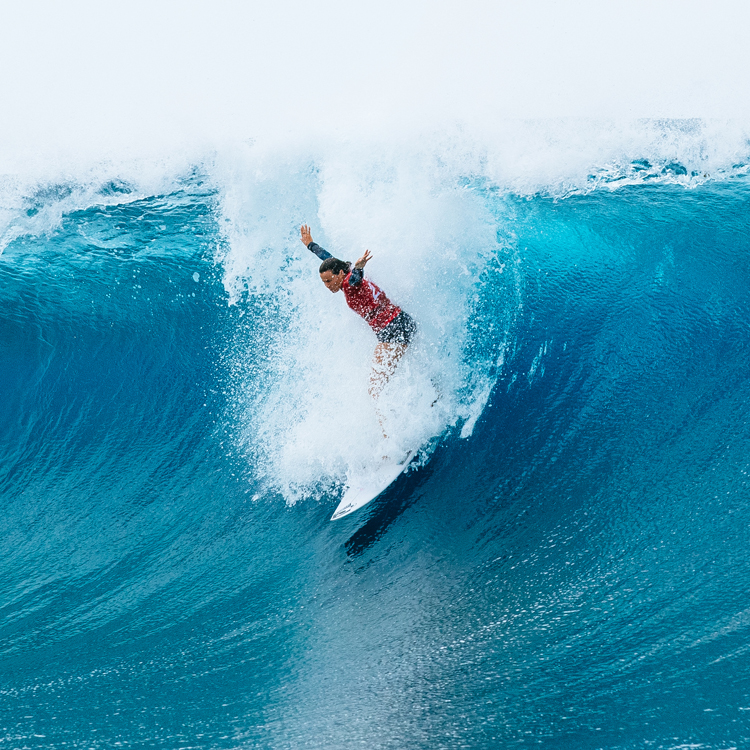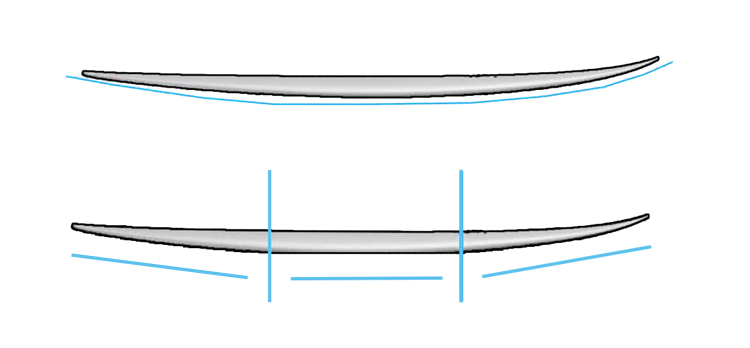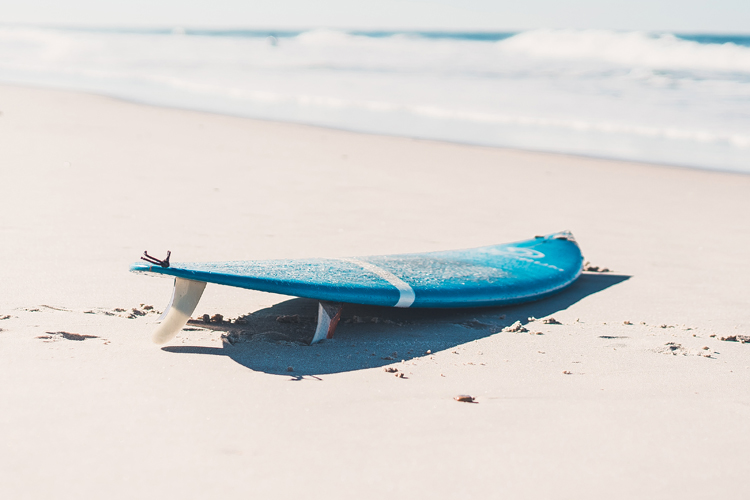One of the most critical components of a surfboard is its "rocker" - the arc or curve of the board from nose to tail. This element significantly influences the board's performance, affecting everything from speed to maneuverability.
Think of a surfboard's rocker as its spine - the subtle or pronounced curvature that spans from the tail (back end) to the nose (front end).
It comprises two key parts: the tail rocker, which is the lift in the board's tail, and the nose rocker, which is the lift at the board's front.
"Rocker contributes to maneuverability. When you're going around a corner, rocker goes around the corner with less drag," surf legend Dick Brewer wrote in "The Surfboard Book."
Therefore, the rocker not only determines the board's shape but is also crucial to how it responds to waves and the surfer's movements.
The extent of the rocker's curve can vary significantly, affecting how the board rides.
A flatter rocker will naturally trace a larger circle when turning, enabling smoother, more gradual arcs at high speed.
Conversely, a board with a more pronounced rocker will trace smaller, tighter circles, offering increased responsiveness and control, particularly in steep or near-breaking waves.

The Pros and Cons of Surfboard Rocker
Choosing the appropriate rocker for your surfboard isn't a one-size-fits-all scenario.
It depends on your skill level, the waves you plan to ride, and your style.
To get a comprehensive understanding, let's consider the advantages and disadvantages of more or less rocker.
More Rocker
Advantages
- Improved Turning: With a more pronounced curve, the surfboard can execute sharper, more aggressive turns. This characteristic is particularly advantageous when navigating steep or breaking waves;
- Prevents Nose-Diving: More rocker is useful on steep drops, offering better resistance to nose-diving or pearling. The curvature of the board is better aligned with the wave surface, reducing the risk of the board piercing through the wave;
- Late Take-Offs: A more curvey surfboard will adapt better to steeper and hollower wave faces;
Disadvantages
- Reduced Speed: More rocker means slower straight-line speed, as the board has to push through and displace more water to progress;
- Harder to Paddle: Heavily rockered boards can be more challenging to paddle as they don't plane as well on water, leading to more resistance and less glide;
- Loss of Fin Hold: The more rocker the board has, the more likely the tail and fins will disengage as you lean forward, leading to rotation and side slip;
Less Rocker
Advantages
- Increased Speed: Less rocker means faster straight-line speed. The board's flatter profile allows it to glide across the water with minimal drag;
- Easier to Paddle: A board with a flatter rocker is generally easier to paddle, making it ideal for beginners or for those surfing on smaller, slower waves;
Disadvantages
- Limited Maneuverability: Boards with less rocker have a larger turning radius, making them less agile when trying to perform sharp turns or navigate steep waves;
- Risk of Nose-Diving: Flatter boards are more prone to nose-diving or pearling on steep waves because their straighter rocker doesn't align well with the wave's curve;

Continuous vs. Staged Rocker
Two primary types of rocker design are often discussed in shaping circles: continuous rocker and staged rocker. Each has its unique characteristics and advantages.
Continuous Rocker
On the other hand, a surfboard with a continuous rocker features an unbroken, smooth curve from nose to tail.
There are no distinct flat sections or abrupt changes; the rocker's curve is consistent and flows throughout the board's length.
Pros
Increased Maneuverability: The unbroken curve allows for smooth, easy turns and offers excellent control in a variety of wave conditions;
Versatility: The seamless transition across the length of the board can handle a wider range of waves, from small, mellow swells to larger, steeper waves;
Cons
Reduced Speed: The consistent curve can generate more drag, reducing the board's speed, especially in a straight line;
More Effort to Paddle: Surfboards with a continuous rocker can require more effort to paddle due to the increased water resistance across the board's entire length;

Staged Rocker
A surfboard with a staged rocker has distinct flat sections separated by more abrupt curves.
This design essentially breaks the rocker into separate "stages," hence the name. Typically, you'll find a flatter mid-section, with the nose and tail having their individual upward curves.
Pros
Higher Speed: The flat middle section decreases drag, allowing the surfboard to maintain higher speeds;
Stability: The distinct flat stage provides a stable platform, making these boards good for beginners or in conditions with smaller waves;
Cons
Limited Maneuverability: The separate stages can impede fluid transitions during turns, making it more challenging to execute quick or sharp maneuvers;
Risk of Catching: The abrupt changes in the rocker's curve can cause the edges of the stages to catch on the water, particularly in choppy conditions or during aggressive turns;
Measuring Rocker
Shapers use a stable surface to lay the surfboard blank bottom up and then use a variety of tools to measure the rocker.
The first thing they must do is to identify the center of the board.
To do so, place a long straight edge over the board's bottom and find the tangent so that the measuring device is balanced.
Then, measure the distance between the tip of the nose and tail and the straight edge.
Surfboard shapers sometimes use female rocker templates and adjustable jigs that can be used to monitor the construction and mold any winning or famous template.
Customization
While there are general rules regarding rocker design, surfboard shapers often adjust these based on the surfer's style and wave conditions.
For instance, renowned surfer and shaper Bob McTavish advises, "For speed, you need a tail rocker not exceeding the slope curve, but that gives you a lot of room for a fair bit of tail rocker."
"It's only on giant open arced faces that you need to get rid of tail rocker, but anywhere around the barrel, you can use a fair bit of tail rocker without inducing drag."
Furthermore, the rocker isn't uniform across the board's width.
Shapers often incorporate differing curves from the board's central stringer to the rails, giving the board a complex three-dimensional shape that can be fine-tuned for specific surfing conditions.
Nevertheless, as a general rule of thumb, it's fair to conclude the following:
- Powerful, Hollow, and Steep Waves: Surfboards with more rocker;
- Small, Weak, and Fat Waves: Surfboards with less rocker;
